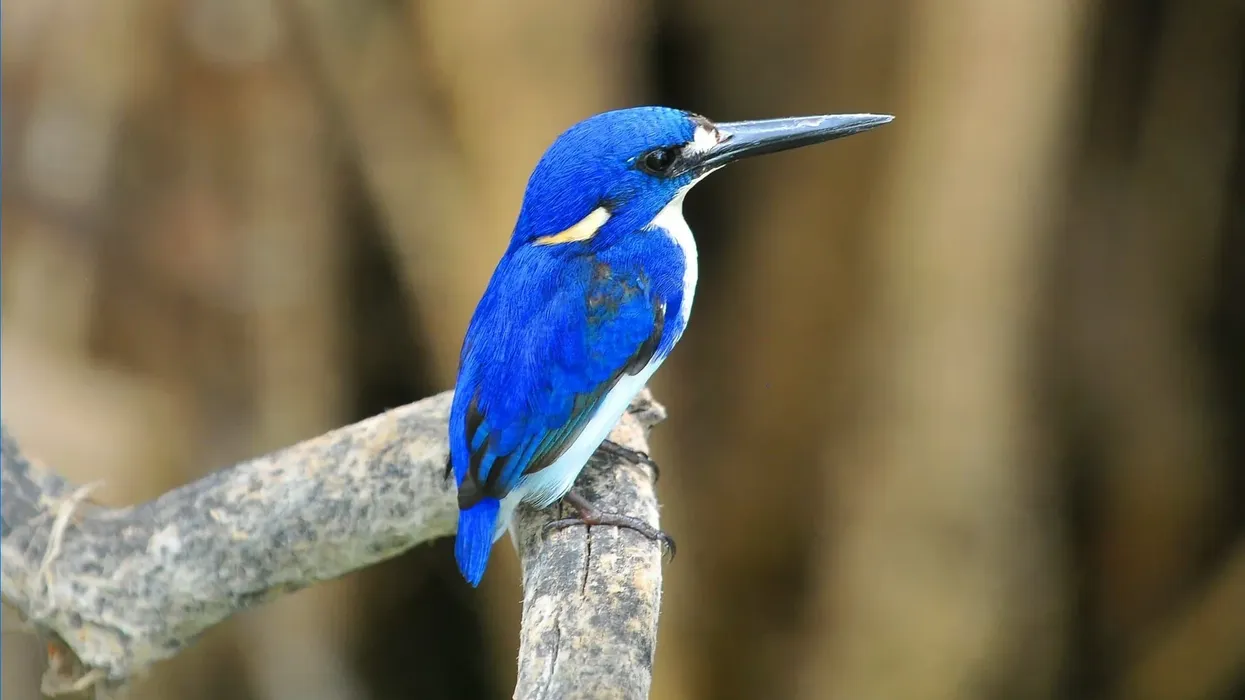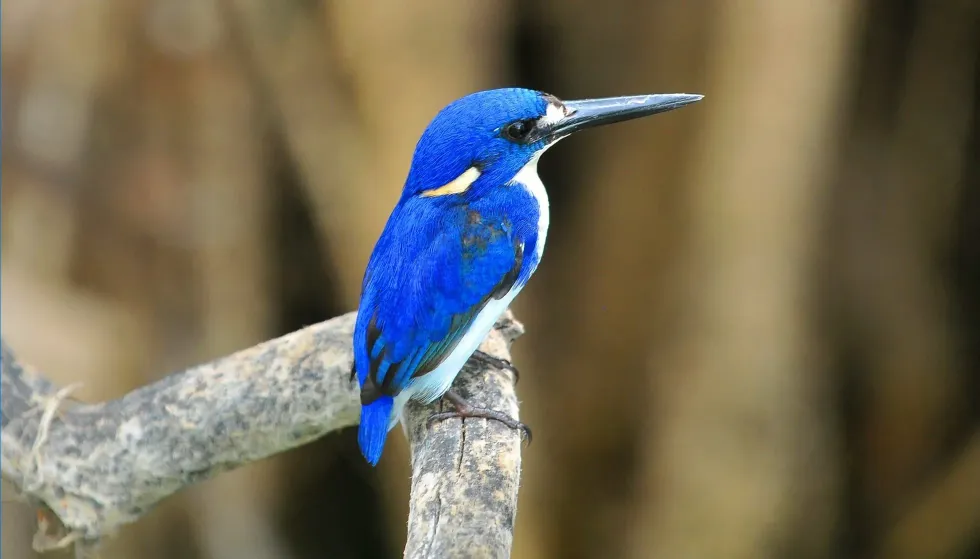Imagine the beauty of a blue-colored bird flying in the blue sky! Yes! A little kingfisher, Ceyx pusillus or Alcedo pusilla, has glossy blue and snow-white feathers over its body. It is a species of kingfishers.
The Ceyx pusillis is recorded to cover a narrow distribution range throughout the dark rain forest, coastal islands, mangroves, and near the river of Australia. Specifically, it inhabits the northern coastal islands of Queensland in the north and northern Australia. It is also located in Papua New Guinea, the Solomon Islands, and the mangrove forest of Australia.
While it is uncommon species of birds in northeast Queensland, it prefers dark, narrow coastal islands and the mangrove forest near the river. The breeding region of Ceyx pusillis ranges from the Solomon Islands to Papua New Guinea in Australia. It also has several subspecies including Ceyx pusillus ramsayi, Ceyx pusillus halli, Ceyx pusillus pusillus, and more.
If the uniqueness of the little kingfisher makes you interested to read more about similar species, you can read about the sanderling and green heron.
Little Kingfisher Interesting Facts
What type of animal is a little kingfisher?
The little kingfishers, known as Ceyx pusillus or Alcedo pusillus in Latin, are a species of kingfisher birds that are quite uncommon in the world with several subspecies including Ceyx pusillus ramsayi, Ceyx pusillus halli, Ceyx pusillus pusillus, and more.
What class of animal does a little kingfisher belong to?
The species of little kingfishers belong to the class Aves, genus Ceyx, and the family Alcedinidae. It is one of the smallest kingfishers found in north Queensland and northwest New Guinea.
How many little kingfishers are there in the world?
While the little kingfishers are quite an uncommon species of bird, their distribution range remains undeciphered. The population is categorized as Least Concern under the IUCN Red List of Threatened Species.
Where does a little kingfisher live?
The little kingfisher range map highlights northern Queensland, Indonesia, Papua New Guinea, and the Solomon Islands of Australia. During the breeding season, the species is often recorded from the Solomon Islands to Papua New Guinea.
What is a little kingfisher's habitat?
The little kingfisher and its nest are found in coastal islands, mangrove forests, woodlands, and other waterways. The parent builds a nesting chamber around their desired habitat during the breeding season, wherein eggs are laid.
Who do little kingfishers live with?
While a little kingfisher is not reported to have a friendly temperament, the reports do not highlight who the species live with and how. It is speculated that the species perch above the water in a flock and prefer to live with the species, making up its diet, to feed upon.
How long does a little kingfisher live?
While the exact lifespan of the little kingfishers remains unknown, the kingfishers are reported to live up to 15 years and more while the initial three to four months are spent under the protection of their parents.
How do they reproduce?
The breeding season of the parents of a kingfisher ranges from October to March in species of little kingfisher (Queensland). The eggs are laid in a chamber at the end of the ground.
Around two to three white eggs are laid post the breeding period. The eggs hatch into chicks, the chicks are fed by the parents who carry food in the nesting chamber of the burrow.
What is their conservation status?
The species of little kingfishers, from the family Alcedinidae, residing in the mangrove forests and coastal islands like the Solomon Islands are categorized as Least Concern under the IUCN Red List of Threatened Species.
Little Kingfisher Fun Facts
What do little kingfishers look like?
The kingfisher bird is a tiny bird with a blue-colored back and head and snow-white breast. While the bill is heavy, the tail is reportedly short. The color of the feet, legs, and bill ranges from dark brown to black. It has a white spot before the eyes and on either side of the neck; and has three toes.
The eggs of the species are recorded to be white-colored and round in shape, that hatch into individual young species.
How cute are they?
The glossy blue bird is often reported to leave people awestruck with its beauty. The young ones being nurtured and groomed by their parents is another pleasant sight to behold.
How do they communicate?
According to the search reports, the uncommon species of Ceyx pusillus is reported to communicate through a distinctive call and other vocalization mechanisms. The call of the bird sounds like shrill whistles. The call is often high-pitched and inaudible to humans.
How big is a little kingfisher?
The Ceyx pusillus is 4.5-5 in (11.5-13 cm) long. It is approximately 20 times smaller than the largest species of bird in the world, i.e. an ostrich.
How fast can a little kingfisher fly?
The speed of the little kingfisher, Ceyx pusillus or Ceyx pusilla, is not yet computed, while the flight of a belted kingfisher is recorded to be 36 mph (58 kph). The search states that the flight of the little kingfisher is fast, and often low near the water bodies.
Further, the search also highlighted that the species make a distinctive high pitched call, while their flight that sounds like 'tzeit tzeit'. They are also recorded to dive quite deep in water to feed on the prey.
How much does a little kingfisher weigh?
The weight of little kingfishers ranges from 0.3-0.5 oz (10-15 g). They are three times heavier than the common kingfisher.
What are the male and female names of the species?
There are no sex-specific names of the species. They can be called little kingfisher male or little kingfisher female, respectively. The species is called Ceyx pusillus or Ceyx pusilla and Alcedo pusilla in Latin.
What would you call a baby little kingfisher?
The little kingfisher baby can be called a chick, fledging, or hatchling.
What do they eat?
The little kingfishers are recorded to perch above the water, thus, the little kingfisher diet comprises insects, crustaceans, small fish, frogs, annelid worms, mollusks, water spiders, and reptiles including sea snakes. The feeding habits of birds are recorded to have a similar mechanism to that of an azure kingfisher.
They beat the prey on the ground and often perch to shatter the bones before they feed on the prey. They are known to dive deep into the water to catch prey.
Are they poisonous?
No, the search does not reflect kingfishers or their subspecies as poisonous birds. They do not possess any sort of danger.
Would they make a good pet?
Kingfishers are wild birds perching near the water, feeding on birds, and thus, do not make good pets. The species neither have a friendly behavior nor is it legal to own one around many countries in the world.
Did you know...
The little kingfishers are reported to build the nest in the mangrove covers. Also, chambers are formed to lay eggs in the burrows.
The breeding season varies from place to place and species to species. For instance, the breeding season of the subspecies of Queensland ranges from October to March.
The young ones are fed by parents for initial three to four months before they take their first flight.
The flight of the bird is quick and is often reported to bob its head and wings while preying on a fish.
While the conservation status of the little kingfisher, Ceyx pusillus or Alcedo pusilla, is listed to be Least Concern, the distribution of populations of the kingfishers is speculated to be decreasing due to destruction of habitat, specifically the nest, and threats from predators such as cats, and competition with rats for food.
While the New Zealand kingfishers are considered holy birds in New Zealand, only two species of kingfishers are recorded in the country. Moreover, their population is scarce too.
A kingfisher and its subspecies are speculated to be a symbol of peace, love, and promising prosperity.
How did the kingfisher get its name?
Kingfisher emerges from the phrase 'king's fisher'. The bird was named kingfisher for reasons not yet documented. It is speculated that the species are called kingfishers as they were observed to be great fishers as they preyed on fish and perched above the water.
How are the kookaburra and kingfisher different?
A kingfisher belongs to the suborder Alcedo, on the other hand, a kookaburra belongs to the genus Dacelo and is a subspecies of kingfishers. While a kingfisher has a large head, short tail, and feeds on fish, the kookaburra is known for its laugh-like call and is also known as laughing kookaburra.
Here at Kidadl, we have carefully created lots of interesting family-friendly animal facts for everyone to discover! Learn more about some other birds from our Australian pelican facts and reddish egret facts pages.
You can even occupy yourself at home by coloring in one of our free printable little kingfisher coloring pages.










